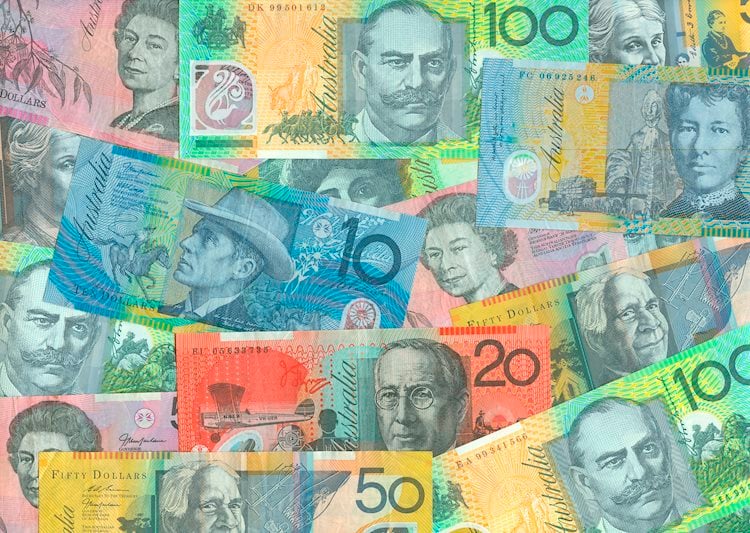- AUD/USD rebounds strongly from an eight-month low of 0.6350 as the US Dollar hits hard.
- Dismal market sentiment keeps the Australian Dollar on edge.
- Investors await the US ISM Services PMI for July and the RBA monetary policy.
The AUD/USD pair bounces back strongly after posting a fresh eight-month low near 0.6350 in Monday’s European session. The Aussie asset recovers as the US Dollar (USD) tumbles to a fresh four-month low but still remains negative due to weak Australian Dollar (AUD).
Escalating Middle East tensions and risks of the United States (US) economic slowdown have prompted risk-aversion in global markets. This has dampened the appeal of risk-sensitive assets. Fears of a US slowdown stemmed from cooling labor market conditions and a sharp contraction in activities in the manufacturing sector.
The Aussie is under severe pressure due to dismal market sentiment. S&P 500 futures have faced a bloodbath in European trading hours, exhibiting a sharp decline in investors’ risk appetite. The US Dollar Index (DXY), which tracks the Greenback’s value against six major currencies, slides sharply to near 102.60.
Meanwhile, the next trigger for the Australian Dollar will be the Reserve Bank of Australia’s (RBA) interest-rate decision, which will be announced on Tuesday. The RBA is expected to leave its key Official Cash Rate (OCR) unchanged at 4.35%. Therefore, investors will majorly focus on the interest rate guidance.
In Monday’s session, investors will focus on the US ISM Services PMI for July, which will be published at 14:00 GMT. The PMI report is expected to show that activities in the services sector expanded to 51.0 after contracting to 48.8. Investors will also focus on other Services PMI indexes, such as Prices Paid and New Orders, which indicate changes in input prices and forward demand, respectively.
Australian Dollar FAQs
One of the most significant factors for the Australian Dollar (AUD) is the level of interest rates set by the Reserve Bank of Australia (RBA). Because Australia is a resource-rich country another key driver is the price of its biggest export, Iron Ore. The health of the Chinese economy, its largest trading partner, is a factor, as well as inflation in Australia, its growth rate and Trade Balance. Market sentiment – whether investors are taking on more risky assets (risk-on) or seeking safe-havens (risk-off) – is also a factor, with risk-on positive for AUD.
The Reserve Bank of Australia (RBA) influences the Australian Dollar (AUD) by setting the level of interest rates that Australian banks can lend to each other. This influences the level of interest rates in the economy as a whole. The main goal of the RBA is to maintain a stable inflation rate of 2-3% by adjusting interest rates up or down. Relatively high interest rates compared to other major central banks support the AUD, and the opposite for relatively low. The RBA can also use quantitative easing and tightening to influence credit conditions, with the former AUD-negative and the latter AUD-positive.
China is Australia’s largest trading partner so the health of the Chinese economy is a major influence on the value of the Australian Dollar (AUD). When the Chinese economy is doing well it purchases more raw materials, goods and services from Australia, lifting demand for the AUD, and pushing up its value. The opposite is the case when the Chinese economy is not growing as fast as expected. Positive or negative surprises in Chinese growth data, therefore, often have a direct impact on the Australian Dollar and its pairs.
Iron Ore is Australia’s largest export, accounting for $118 billion a year according to data from 2021, with China as its primary destination. The price of Iron Ore, therefore, can be a driver of the Australian Dollar. Generally, if the price of Iron Ore rises, AUD also goes up, as aggregate demand for the currency increases. The opposite is the case if the price of Iron Ore falls. Higher Iron Ore prices also tend to result in a greater likelihood of a positive Trade Balance for Australia, which is also positive of the AUD.
The Trade Balance, which is the difference between what a country earns from its exports versus what it pays for its imports, is another factor that can influence the value of the Australian Dollar. If Australia produces highly sought after exports, then its currency will gain in value purely from the surplus demand created from foreign buyers seeking to purchase its exports versus what it spends to purchase imports. Therefore, a positive net Trade Balance strengthens the AUD, with the opposite effect if the Trade Balance is negative.













